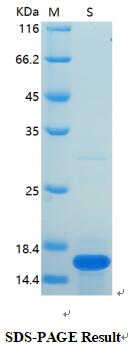Product Name :
CD3Z Recombinant Protein Swiss-Prot :
P20963 Host :
E.coli Tag :
≥0.5mg/ml Amino acid Sequence :
RVKFSRSADAPAYQQGQNQLYNELNLGRREEYDVLDKRRGRDPEMGGKPQRRKNPQEGLYNELQKDKMAEAYSEIGMKGERRRGKGHDGLYQGLSTATKDTYDALHMQALPPR Restriction sites :
NdeI-XhoI Background :
When T cells encounter antigens via the T cell receptor (TCR), information about the quantity and quality of antigens is relayed to the intracellular signal transduction machinery. This activation process depends mainly on CD3 (Cluster of Differentiation 3), a multiunit protein complex that directly associates with the TCR. CD3 is composed of four polypeptides: ζ, γ, ε and δ. Each of these polypeptides contains at least one immunoreceptor tyrosine-based activation motif (ITAM). Engagement of TCR complex with foreign antigens induces tyrosine phosphorylation in the ITAM motifs and phosphorylated ITAMs function as docking sites for signaling molecules such as ZAP-70 and p85 subunit of PI-3 kinase. TCR ligation also induces a conformational change in CD3ε, such that a proline region is exposed and then associates with the adaptor protein Nck. The CD3ζ invariant chain is a type-I transmembrane protein that exists in the TCR signaling complex as a disulfide-linked homodimer. The cytoplasmic tail of each CD3ζ monomer contains three distinct ITAM motifs, each containing two tyrosine residues. Phosphorylation of CD3ζ ITAM tyrosine residues, including Y142, is driven by recruitment of the Lck and Fyn tyrosine kinases to the TCR. Lck/Fyn-mediated ITAM phosphorylation creates docking sites that promote the SH2 domain-dependent recruitment and activation of ZAP-70, which drives amplification of signaling events downstream of the TCR that facilitate T cell activation. Phosphorylation of a pool of p16 CD3ζ leads to the generation of p21 and p23 species, which differ in the degree of ITAM phosphorylation. It has been proposed that the ratio of p21/p23 contributes to regulating the amplitude of T cell activation. CD3ζ plays an important role in the assembly and surface expression of the TCR complex. Indeed, research studies have demonstrated that CD3ζ is degraded in response to Ag-dependent TCR stimulation as a mechanism to tightly control T cell activation. Soluble :
PBS, 4M Urea, PH7.4 Purification&Purity :
Transferred into competent cells and the supernatant was purified by NI column affinity chromatography and the purity is > 85% (by SDS-PAGE). Storage&Stability :
Store at 4°C short term. Aliquot and store at -20°C long term. Avoid freeze-thaw cycles. Expression vector :
pet-22b(+) BiowMW :
~12kDa Note :
For research use only, not for use in diagnostic procedure. concentration :
≥0.5mg/ml
CD3Z Recombinant Protein Swiss-Prot :
P20963 Host :
E.coli Tag :
≥0.5mg/ml Amino acid Sequence :
RVKFSRSADAPAYQQGQNQLYNELNLGRREEYDVLDKRRGRDPEMGGKPQRRKNPQEGLYNELQKDKMAEAYSEIGMKGERRRGKGHDGLYQGLSTATKDTYDALHMQALPPR Restriction sites :
NdeI-XhoI Background :
When T cells encounter antigens via the T cell receptor (TCR), information about the quantity and quality of antigens is relayed to the intracellular signal transduction machinery. This activation process depends mainly on CD3 (Cluster of Differentiation 3), a multiunit protein complex that directly associates with the TCR. CD3 is composed of four polypeptides: ζ, γ, ε and δ. Each of these polypeptides contains at least one immunoreceptor tyrosine-based activation motif (ITAM). Engagement of TCR complex with foreign antigens induces tyrosine phosphorylation in the ITAM motifs and phosphorylated ITAMs function as docking sites for signaling molecules such as ZAP-70 and p85 subunit of PI-3 kinase. TCR ligation also induces a conformational change in CD3ε, such that a proline region is exposed and then associates with the adaptor protein Nck. The CD3ζ invariant chain is a type-I transmembrane protein that exists in the TCR signaling complex as a disulfide-linked homodimer. The cytoplasmic tail of each CD3ζ monomer contains three distinct ITAM motifs, each containing two tyrosine residues. Phosphorylation of CD3ζ ITAM tyrosine residues, including Y142, is driven by recruitment of the Lck and Fyn tyrosine kinases to the TCR. Lck/Fyn-mediated ITAM phosphorylation creates docking sites that promote the SH2 domain-dependent recruitment and activation of ZAP-70, which drives amplification of signaling events downstream of the TCR that facilitate T cell activation. Phosphorylation of a pool of p16 CD3ζ leads to the generation of p21 and p23 species, which differ in the degree of ITAM phosphorylation. It has been proposed that the ratio of p21/p23 contributes to regulating the amplitude of T cell activation. CD3ζ plays an important role in the assembly and surface expression of the TCR complex. Indeed, research studies have demonstrated that CD3ζ is degraded in response to Ag-dependent TCR stimulation as a mechanism to tightly control T cell activation. Soluble :
PBS, 4M Urea, PH7.4 Purification&Purity :
Transferred into competent cells and the supernatant was purified by NI column affinity chromatography and the purity is > 85% (by SDS-PAGE). Storage&Stability :
Store at 4°C short term. Aliquot and store at -20°C long term. Avoid freeze-thaw cycles. Expression vector :
pet-22b(+) BiowMW :
~12kDa Note :
For research use only, not for use in diagnostic procedure. concentration :
≥0.5mg/ml
Blocking peptide available as NCP0206P

 CD3Z Recombinant Protein
CD3Z Recombinant Protein 
 Datasheet
Datasheet COA
COA MSDS
MSDS SHIP
SHIP